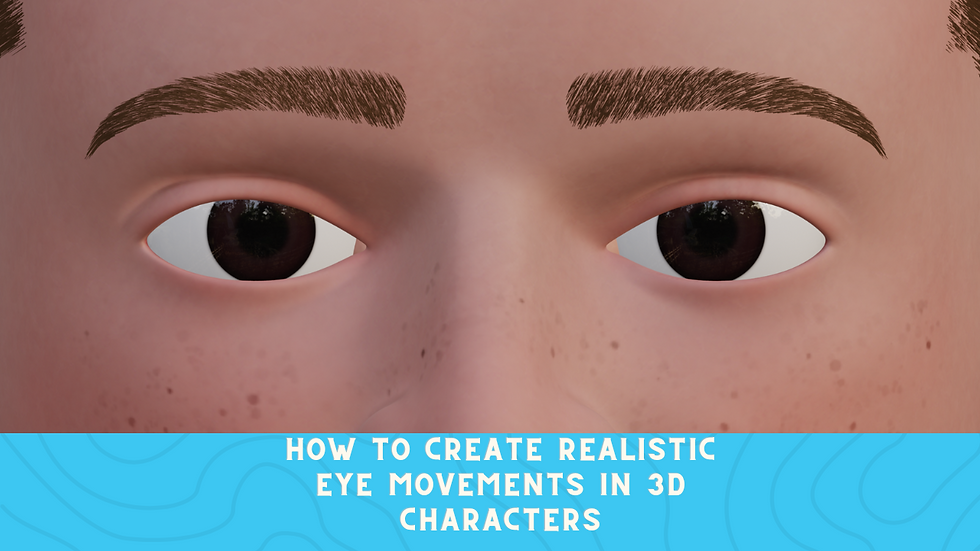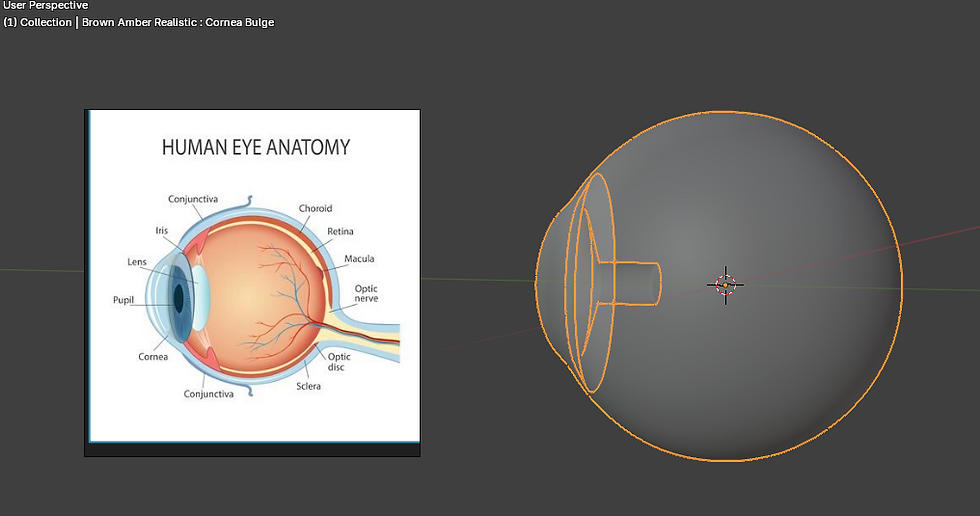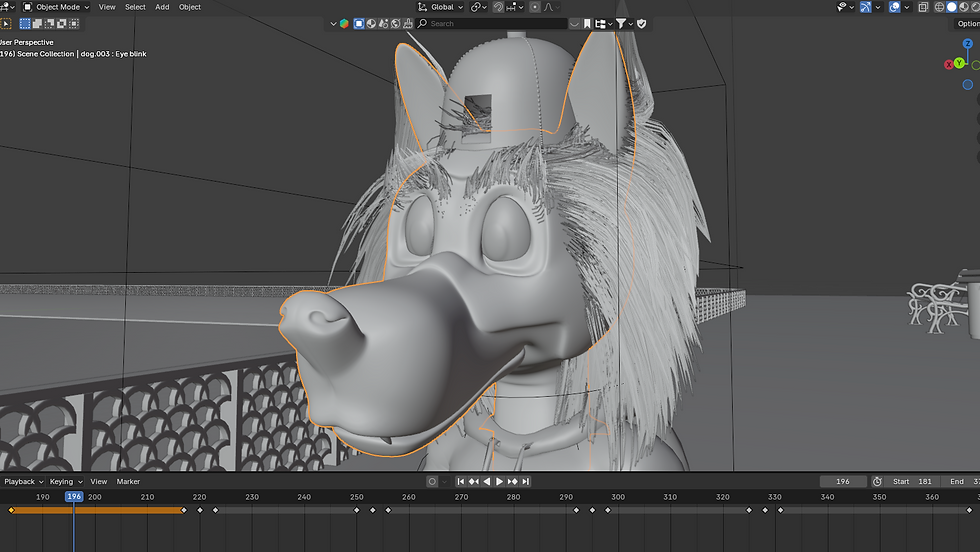How to Create Realistic Eye Movements in 3D Characters
- Parth Ashara
- Jan 7
- 9 min read

When it comes to crafting truly immersive 3D Characters, nothing adds more life and realism than realistic eye movements. The way a character's eyes move can transform an animation, making the character feel expressive, engaging, and connected to its environment. At Whizzy Studios, we believe in the power of details like eye rigging to bring characters to life.
QUICK LINKS :
The importance of realistic eye movements in character animation cannot be overstated. Eyes are not just functional—they are emotional storytellers. By leveraging advanced 3D Character Design, including hire dedicated 3D character designers, you ensure your animation stands out. Small elements like natural eye movements, blink animation, and pupil dilation simulation can make your characters feel alive.
Achieving lifelike eye movements requires a mix of techniques. At Whizzy Studios, we focus on tools like inverse kinematics for eyes, motion capture for eye movements, and procedural animation to craft stunning visuals. We also integrate micro eye movements and gaze tracking to ensure your characters connect with their environment seamlessly.
Ready to elevate your animations? Dive into the world of professional 3D Character Design and let Whizzy Studios guide you toward perfection. By working with experts, you can create expressive eyes in 3D animation that captivate audiences and leave a lasting impression. Don't wait—hire a dedicated 3D character designer today!
Understanding Human Eye Anatomy and Movement

To create realistic eye movements in 3D Characters, it’s essential to start with a solid understanding of human eye anatomy and how the eyes move in real life. At Whizzy Studios, we emphasize that mastering these details is the foundation of lifelike 3D Character Design.
Structure of the Human Eye
The human eye is a complex organ, made up of components like the cornea, iris, pupil, and retina. These parts work together to capture light and interpret the world around us. For realistic eye movements, animators need to replicate the interaction of these components. For instance, incorporating pupil dilation simulation and subtle shifts in the iris can add depth and believability to your 3D Characters.
Using advanced eye rigging techniques, such as those developed by the experts at Whizzy Studios, ensures that these details are accurately represented. Want to bring this level of detail to your projects? Hire a dedicated 3D character designer and take your animation to the next level.
Types of Eye Movements
There are three primary types of eye movements that animators need to consider:
Saccades: These are quick, jerky movements that shift the eye from one focus point to another. Recreating these with subtle variations can prevent your 3D Characters from appearing mechanical.
Smooth Pursuit: These occur when the eye follows a moving object. Incorporating natural eye movements like these can be achieved with techniques such as manual keyframing or procedural animation.
Fixation: This is when the eye remains steady, focusing on a single point. Adding micro eye movements during fixation keeps your characters’ eyes alive and engaging.
At Whizzy Studios, we integrate these types of movements seamlessly into our 3D Character Design process. By utilizing tools like motion capture for eye movements, we ensure that each movement, whether a blink animation or a subtle gaze shift, feels authentic.
Looking to incorporate these techniques? Explore 3D Character Design with our team, or hire a dedicated 3D character designer to make your project stand out!
Key Principles of Eye Animation
Creating realistic eye movements for 3D Characters requires adherence to several key principles that elevate the animation from mechanical to lifelike. At Whizzy Studios, we ensure every detail, from head and eye synchronization to subtle speed variations, is crafted to perfection through expert 3D Character Design.
Synchronization with Head and Facial Movements
The eyes do not move independently; they are intricately connected to the head and facial muscles. Proper eye rigging ensures that eye movements are naturally aligned with head turns, nods, and facial expressions. This synchronization brings cohesion to your animations, making your 3D Characters appear more lifelike. Tools like inverse kinematics for eyes, utilized by Whizzy Studios, are essential for achieving this level of detail.
For example, during a blink animation, the eyelids should match the movement of the surrounding facial muscles, and subtle micro eye movements can further enhance realism. Ready to incorporate these principles? Hire a dedicated 3D character designer to refine your animations.
Timing and Speed Considerations
In nature, eye movements are not uniform. They vary in timing and speed depending on the action—saccades are quick and abrupt, while smooth pursuit movements are fluid and steady. These variations must be replicated in animation to avoid stiffness or unnatural behavior.
At Whizzy Studios, we use manual keyframing and procedural animation techniques to create dynamic and realistic eye movements that adapt to the character's environment and emotions. Gaze tracking and focus adjustment further enhance believability.
Avoiding Mechanical or Overly Symmetrical Movements
One common pitfall in 3D Character Design is creating eyes that move too symmetrically or repetitively, which can make a character look robotic. Instead, slight variations in natural eye movements, including pupil dilation simulation and asynchronous blinks, add depth and personality to your characters.
For the best results, trust the experts at Whizzy Studios to implement these nuances. Our team combines expertise in motion capture for eye movements and procedural animation to bring expressive eyes in 3D animation to life. Want your project to stand out? Explore our professional services in 3D Character Design or hire a dedicated 3D character designer today!
Techniques for Animating Eye Movements

Crafting realistic eye movements for 3D Characters demands a blend of artistry and technology. At Whizzy Studios, we utilize various advanced techniques to bring eyes to life, ensuring that every glance and gaze feels authentic. Below are three key approaches to animating eye movements effectively.
Manual Keyframing: Crafting Eye Movements Frame by Frame
Manual keyframing is a fundamental technique in 3D Character Design. This method allows animators to control every movement of the eyes, from subtle micro eye movements during fixation to quick saccades. While it’s time-intensive, manual keyframing provides unparalleled precision and creative flexibility.
By carefully adjusting timing, speed, and direction, animators can create natural eye movements that feel fluid and human. For projects requiring this meticulous attention to detail, hire a dedicated 3D character designer who specializes in lifelike animations.
Procedural Animation: Using Algorithms to Automate Movements
For projects requiring consistent results and efficiency, procedural animation is a powerful solution. Using algorithms, animators can simulate gaze tracking, pupil dilation simulation, and blink animation automatically. This technique ensures the eyes adapt dynamically to changes in the character’s environment.
At Whizzy Studios, we integrate procedural animation into our workflows to balance efficiency and quality. This approach is especially useful for creating inverse kinematics for eyes, ensuring smooth head and eye synchronization.
Motion Capture: Capturing Real Human Eye Movements for Reference
One of the most effective ways to achieve expressive eyes in 3D animation is through motion capture for eye movements. By tracking real human eye behavior, animators gain valuable references that can be applied to their characters. This method captures nuances like smooth pursuit, natural hesitations, and subtle shifts in focus.
Using motion capture, the team at Whizzy Studios brings unparalleled realism to their 3D Characters. The data is then refined with manual keyframing or enhanced through procedural animation, ensuring a perfect blend of authenticity and creativity.
Whether you prefer the control of manual keyframing, the efficiency of procedural
animation, or the authenticity of motion capture, each technique has its strengths. At Whizzy Studios, our expertise in 3D Character Design ensures your characters' eyes convey emotion and depth. Ready to elevate your project? Hire a dedicated 3D character designer today and let your animations shine!
Implementing Eye Movements in 3D Software
Once the principles and techniques of realistic eye movements are understood, the next step is bringing them to life using 3D software. At Whizzy Studios, we focus on combining technical precision with artistic vision to create compelling 3D Characters with lifelike eye movements. Here’s how it’s done:
Setting Up Eye Rigs and Controls
The foundation of any eye animation starts with a well-constructed eye rig. Eye rigs provide animators with controls to manipulate movements, allowing for dynamic adjustments. Proper rigging enables natural eye movements, such as saccades, smooth pursuit, and fixation, which add believability to the character.
By collaborating with Whizzy Studios, you can ensure your characters are equipped with advanced rigging systems. Our experts in 3D Character Design specialize in creating rigs that streamline workflows while maintaining creative flexibility. Ready to enhance your project? Hire a dedicated 3D character designer to get started.
Constraints and Parenting for Realistic Motion
To achieve seamless integration of eye movements with the rest of the character, constraints and parenting are essential. For example:
Look-at constraints help ensure the eyes stay focused on a target.
Parenting the eyes to the head rig ensures head and eye synchronization, making movements feel organic.
These techniques are vital for achieving precise gaze tracking and focus adjustment, especially in interactive animations. At Whizzy Studios, we incorporate these systems into our designs to produce realistic eye movements that flow naturally.
Utilizing Inverse Kinematics for Natural Movement
Inverse kinematics (IK) is a powerful tool for creating smooth, natural eye movements. IK allows the animator to control the end position of the eyes while the software calculates the necessary rotations of the eyeballs. This ensures that eye rigging is efficient and precise, especially for complex animations involving simultaneous head and eye synchronization.
At Whizzy Studios, we integrate inverse kinematics for eyes to add flexibility and realism to our 3D Character Design workflows. By combining IK systems with procedural animation and manual keyframing, we bring unparalleled lifelike quality to your characters.
Integrating Eye Movements with Facial Expressions

To achieve truly lifelike animations, realistic eye movements must seamlessly integrate with facial expressions. The eyes play a crucial role in conveying emotions, and their alignment with facial muscles is vital for creating compelling 3D Characters. At Whizzy Studios, we emphasize the importance of this harmony in our 3D Character Design process.
Ensuring Coherence Between Eyes and Facial Muscles
The relationship between the eyes and surrounding facial muscles is intricate. For example, during a smile, subtle changes in the eyelids and brow muscles complement the expression, enhancing emotional depth. Eye rigging and advanced inverse kinematics for eyes allow animators to synchronize eye movements with these facial cues, ensuring natural transitions.
Using techniques like gaze tracking and micro eye movements, we ensure that the eyes not only follow the character’s focus but also react dynamically to their emotions. At Whizzy Studios, our team specializes in combining eye rigging with facial controls to bring coherence to your animations. Want to achieve this level of detail? Hire a dedicated 3D character designer to transform your characters into expressive creations.
Expressing Emotions Through Combined Eye and Facial Animations
Eyes are the focal point of emotional expression. Whether it’s a subtle squint of suspicion or wide-eyed excitement, combining realistic eye movements with nuanced facial animations makes your 3D Characters more engaging. Blink animation, pupil dilation simulation, and natural eye movements can further enhance the emotional resonance of a character.
For example:
A surprised expression might include a sudden widening of the eyes with synchronized upward movement of the eyebrows.
A sad expression might involve slower eye movements, downward gazes, and minimal blinking to reflect contemplation.
By leveraging manual keyframing, procedural animation, and motion capture for eye movements, the experts at Whizzy Studios ensure your animations tell a story through the eyes. These methods help bring out expressive eyes in 3D animation, making your characters unforgettable.
Advanced Techniques
Taking your 3D Characters to the next level requires incorporating advanced methods that enhance the realism of their eye movements. At Whizzy Studios, we specialize in implementing cutting-edge techniques that make your characters’ eyes expressive, lifelike, and captivating. Here are some advanced approaches to consider:
Simulating Pupil Dilation and Contraction
The subtle changes in pupil size—caused by lighting or emotional responses—add an extra layer of realism to 3D Character Design. Pupil dilation simulation can convey emotions such as excitement, fear, or surprise, making your character feel more dynamic and relatable.
Using procedural animation, animators can automate these adjustments in response to environmental factors or scene dynamics. At Whizzy Studios, we integrate these effects seamlessly into our projects. Want to elevate your characters with this detail?
Adding Micro-Movements and Blinks for Realism
Even when a character’s gaze is fixed, their eyes are never entirely still. Incorporating micro eye movements, also known as ocular tremors, ensures that your characters avoid the "dead-eye" effect. Coupled with blink animation, these subtle details create more natural and engaging eye movements.
At Whizzy Studios, we use a mix of manual keyframing and motion capture for eye movements to perfect these small yet impactful details. These techniques ensure your 3D Characters feel alive, even during moments of stillness.
Implementing Gaze Tracking and Focus Adjustments
Gaze tracking is essential for ensuring your characters' eyes follow the intended targets in a scene, whether it’s another character, an object, or a distant horizon. Focus adjustments, on the other hand, add depth by simulating shifts in the eyes’ focal distance, mimicking human vision.
By using inverse kinematics for eyes and advanced constraints, the team at Whizzy Studios ensures seamless integration of gaze tracking and focus adjustments. These features make your characters’ interactions with their surroundings feel authentic and purposeful. Ready to bring this level of detail to your animations? Explore our capabilities in 3D Character Design or hire a dedicated 3D character designer to start today!
Conclusion
Realistic eye movements are the cornerstone of creating engaging and lifelike 3D Characters. They breathe life into animations, making characters not just visually appealing but emotionally expressive. From pupil dilation simulation to micro eye movements and gaze tracking, each technique plays a vital role in achieving this realism.
At Whizzy Studios, we understand the intricate details involved in crafting compelling eye movements. By integrating advanced 3D Character Design techniques, such as manual keyframing, procedural animation, and motion capture for eye movements, we ensure that your characters connect with audiences on a deeper level.
To master this craft, practice is key. Observing real-life eye behavior—whether it’s the subtle blink animation of someone deep in thought or the way natural eye movements follow a target—can provide invaluable insights. As you refine your skills, don’t hesitate to collaborate with professionals to elevate your work.
Ready to take your animations to the next level? Explore our services in 3D Character Design or hire a dedicated 3D character designer to bring your vision to life. Trust Whizzy Studios to turn your characters into captivating creations that resonate with your audience!

Comments